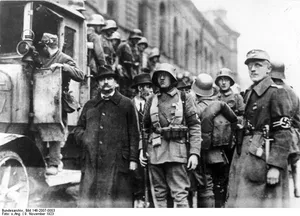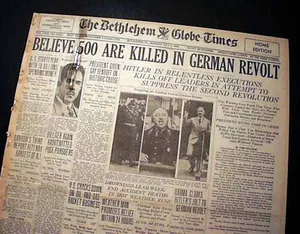Hitler blamed the Weimar Republic’s weakness on the influence of Germany’s Jewish and communist minorities, who he claimed were trying to take over the country. “There are only two possibilities,” he told a Munich audience in 1922. “Either victory of the Aryan, or annihilation of the Aryan and the victory of the Jew.” The young Hitler saw history as a process of racial struggle, with the strongest race—the Aryan race—ultimately prevailing by force of arms. “Mankind has grown great in eternal war,” Hitler wrote. “It would decay in eternal peace.”
Jews represented everything the Nazis found repugnant: finance capitalism (controlled, the Nazis believed, by powerful Jewish financiers), international communism (Karl Marx was a German Jew, and the leadership of the German Communist Party was heavily Jewish), and modernist cultural movements like psychoanalysis and swing music.
Nazi Party foreign policy aimed to rid Europe of Jews and other “inferior” peoples, absorb pure-blooded Aryans into a greatly expanded Germany—a “Third Reich”—and wage unrelenting war on the Slavic “hordes” of Russia, considered by Hitler to be Untermenschen (subhuman).
Once conquered, the Soviet Union would be ruled by the German master race, which would exterminate or subdue millions of Slavs to create lebensraum (living space) for their own farms and communities. In a conquered and racially cleansed Russia, they would work on model farms and factories connected to the homeland by new highways, called autobahns.
Hitler was the ideologue as well as the chief organizer of the Nazi Party. By 1921, the party had a newspaper, an official flag, and a private army—the Sturmabteilung SA (storm troopers)—made up largely of unemployed and disenchanted WWI veterans. By 1923, the SA had grown to 15,000 men and had access to hidden stores of weapons. That year, Hitler and WWI hero General Erich Ludendorff attempted to overthrow the elected regional government of Bavaria in a coup known as the Beer Hall Putsch.
The regular army crushed the rebellion and Hitler spent a year in prison—in loose confinement. In Landsberg Prison, Hitler dictated most of the first volume of his political autobiography, Mein Kampf (My Struggle). The book brought together, in inflamed language, the racialist and expansionist ideas he had been propagating in his popular beer-hall harangues.
After being released from prison, Hitler vowed to work within the parliamentary system to avoid a repeat of the Beer Hall Putsch setback. In the 1920s, however, the Nazi Party was still a fringe group of ultraextremists with little political power. It received only 2.6 percent of the vote in the Reichstag elections of 1928.
But the worldwide economic depression and the rising power of labor unions and communists convinced increasing numbers of Germans to turn to the Nazi Party. The Nazis fed on bank failures and unemployment—proof, Hitler said, of the ineffectiveness of democratic government. Hitler pledged to restore prosperity, create civil order (by crushing industrial strikes and street demonstrations by communists and socialists), eliminate the influence of Jewish financiers, and make the fatherland once again a world power.
By 1932, the Nazis were the largest political party in the Reichstag. In January of the following year, with no other leader able to command sufficient support to govern, President Paul von Hindenburg appointed Hitler chancellor of Germany. Shortly thereafter, a fire broke out in the Reichstag building in Berlin, and authorities arrested a young Dutch communist who confessed to starting it.
Hitler used this episode to convince President Hindenburg to declare an emergency decree suspending many civil liberties throughout Germany, including freedom of the press, freedom of expression, and the right to hold public assemblies. The police were authorized to detain citizens without cause, and the authority usually exercised by regional governments became subject to control by Hitler’s national regime.
Almost immediately, Hitler began dismantling Germany’s democratic institutions and imprisoning or murdering his chief opponents. When Hindenburg died the following year, Hitler took the titles of führer, chancellor, and commander in chief of the army. He expanded the army tremendously, reintroduced conscription, and began developing a new air force—all violations of the Treaty of Versailles.
Hitler’s military spending and ambitious public-works programs, including building a German autobahn, helped restore prosperity. His regime also suppressed the Communist Party and purged his own paramilitary storm troopers, whose violent street demonstrations alienated the German middle class.
This bloodletting—called the “Night of the Long Knives”—was hugely popular and welcomed by the middle class as a blow struck for law and order. In fact, many Germans went along with the full range of Hitler’s policies, convinced that they would ultimately be advantageous for the country.
In 1938, Hitler began his long-promised expansion of national boundaries to incorporate ethnic Germans. He colluded with Austrian Nazis to orchestrate the Anschluss, the annexation of Austria to Germany. And in Hitler’s most brazenly aggressive act yet, Czechoslovakia was forced to surrender the Sudetenland, a mountainous border region populated predominantly by ethnic Germans.
The Czechs looked to Great Britain and France for help, but hoping to avoid war—they had been bled white in World War I—these nations chose a policy of appeasement. At a conclave held at Munich in September 1938, representatives of Great Britain and France compelled Czech leaders to cede the Sudetenland in return for Hitler’s pledge not to seek additional territory. The following year, the German army swallowed up the remainder of Czechoslovakia.
British Prime Minister Neville Chamberlain, one of the signers of the Munich pact, had taken Hitler at his word. Returning to Britain with this agreement in hand, he proudly announced that he had achieved “peace with honor. I believe it is peace for our time.”















No comments:
Post a Comment